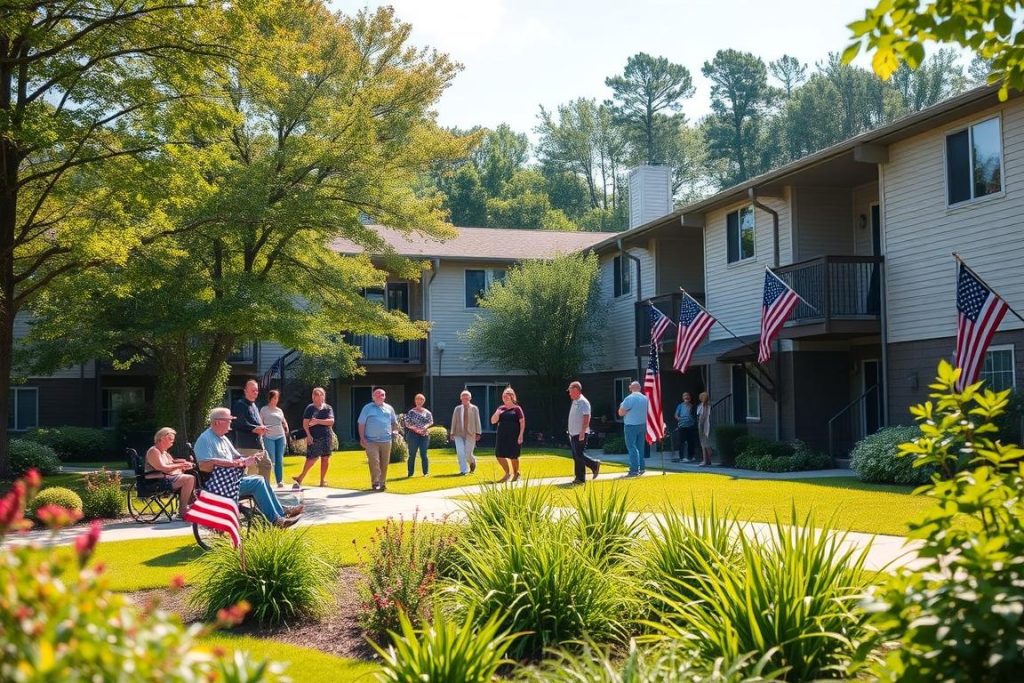Did you know the Chicago Housing Authority (CHA) helps over 20,000 low-income families? Affordable living is harder to find these days. Luckily, there are affordable housing programs ready to help. These are offered by the federal government and local groups like the Illinois Housing Development Authority (IHDA) and the Illinois Department of Human Services (IDHS).
Starting your journey with housing assistance options means learning about federal programs run locally. Agencies like the Department of Housing and Urban Development (HUD) work to increase low-cost rental homes. They also provide emergency housing assistance and aim to make housing more affordable. Understanding these programs is essential. It highlights the importance of these efforts in creating fair housing, economic independence, and healthier lives for all.
Key Takeaways
- The Chicago Housing Authority assists over 20,000 low-income households with various affordable housing options.
- Programs like LIHTC, Tenant-Based Rental Assistance, and Public Housing help improve the supply of affordable homes.
- IDHS currently accepts applications for rental assistance, which do not require proof of citizenship.
- The ILHousingSearch.org platform offers customized searches for affordable housing based on specific needs and budget.
- Federal and local initiatives are essential to ensuring equitable and affordable living opportunities.
Understanding Federal Housing Programs
Federal housing programs offer affordable and accessible homes to many Americans. Knowing about these programs can help you find housing grants, rental help, and low-income housing. This makes finding a home that suits your needs easier.
Low Income Housing Tax Credit (LIHTC)
The Low Income Housing Tax Credit (LIHTC) is key to affordable housing finance in the U.S. It gives tax breaks to developers for creating affordable rental homes. These homes must be affordable for low-to-moderate-income people for at least 30 years. LIHTC offers two kinds of tax credits: 9 percent and 4 percent, depending on the project.
Public Housing and Tenant-Based Rental Assistance
Public housing provides about 970,000 units managed by 3,300 Housing Authorities in the US. It helps low-income families, seniors, and disabled persons with rental assistance. Rent is calculated using the Total Tenant Payment (TTP) formula. It’s typically 30% of a tenant’s monthly adjusted income.
The Section 8 Housing Choice Voucher Program also offers rental help for those in need. It supports low-income people, families, seniors, and those with disabilities. The goal is to make more rental housing options available and accessible.
HOME Investment Partnerships Program
The HOME Investment Partnerships Program gives states and localities housing grants. This funds the creation of affordable housing for low-income folks. It supports the construction, purchase, and rehab of affordable homes. Plus, it helps with rental assistance, making decent and affordable housing more accessible.
Community Development Block Grant (CDBG)
The Community Development Block Grant (CDBG) program is essential for communities. Its goal is to create better living environments and expand economic opportunities. It focuses on providing housing and improvement projects for low- and moderate-income people. CDBG funds are used for housing rehab, public facilities upgrades, and other community projects.
Subsidized Housing Programs and Vouchers
In the United States, subsidized housing programs help make rent affordable for low-income people. They send government money directly to apartment owners. This lowers rent for tenants and keeps living standards up. The Section 8 Housing Choice Voucher Program is a key example. It lets people use housing vouchers to help pay their rent.
Public Housing Authorities (PHAs) must give 75 percent of housing vouchers to those making less than 30 percent of the area’s median income. Also, a family’s total income can’t be over 50% of the median income in their living area. Families must spend 30 percent of their income on rent and utilities. They must also cover any rent more than the payment standard. But, this extra amount shouldn’t be over 40 percent of their income. This applies if they choose a pricier unit.

Applying for this help means contacting your local PHA. They connect tenants with landlords. You can find places to live using HUD’s apartment search map. This program helps low-income families, elderly, and disabled people. It offers them affordable and respectable homes.
Landlords are important to this system too. Those wanting to rent to voucher holders can list their properties with PHAs. This way landlords get their payments from the government on time. This helps both Section 8 families and landlords.
Here are some important facts about the Housing Choice Voucher Program:
| Criteria | Details |
|---|---|
| Income Limit | 75% of vouchers for incomes not exceeding 30% of area median income; family income must not exceed 50% of the median income of their residence area. |
| Rent Contribution | Families must pay 30% of adjusted gross income towards rent and utilities; if rent exceeds the payment standard, additional costs are capped at 40% of the adjusted monthly income. |
| Application Process | Initial leasing within PHA jurisdiction for 12 months, annual reexamination of family income and composition, and annual unit inspections for housing quality standards. |
| Mobility | Families can move without losing assistance, provided they notify PHAs and find acceptable alternative housing. |
By using subsidized housing programs and housing vouchers, people can find affordable homes. This matches their budget and helps everyone work towards stable housing. It shows how crucial PHAs are in helping millions in America live better.
Housing Assistance Options for Specific Groups
Some people face big challenges finding the right place to live. This is why special programs are there to help. They make sure everyone has a safe and stable home. Let’s look at what’s available for seniors, veterans, and needy families.
Programs for Seniors and Persons with Disabilities
Seniors and people with disabilities need support to live independently. The Community Care Expansion Program (CCE) has $805 million ready for adult and senior housing projects. The Housing and Disability Advocacy Program (HDAP) also gives homeless and disabled individuals lots of support. This includes help with getting benefits and finding housing.
Veteran Housing Assistance Programs
Veterans need housing help too, after serving our country. The HUD-Veterans Affairs Supportive Housing (HUD-VASH) program is here for them. It combines rent help with other VA support services. This ensures veterans have the help they need to keep a stable home.

Family Unification Program (FUP)
The Family Unification Program (FUP) targets families in the child welfare system. It’s all about reducing homelessness, improving family ties, and avoiding foster care when possible. The Bringing Families Home (BFH) program also supports these families. It provides housing help and more, aiming to keep families together.
| Program | Target Group | Assistance Provided |
|---|---|---|
| CalWORKs Housing Support Program (HSP) | Homeless CalWORKs families | Permanent housing, temporary shelter, moving costs, rental subsidies, case management |
| CalWORKs Homeless Assistance (HA) Program | CalWORKs recipients | Temporary shelter payments, housing maintenance payments |
| Home Safe Program | Abused, neglected, or financially exploited elders and dependent adults | Housing-related assistance, evidence-based practices for homeless prevention |
Conclusion
Living affordably in America is possible thanks to various housing help programs. These include Low Income Housing Tax Credit (LIHTC) and public housing. There’s also special help for older people and veterans. The goal of these programs is to help everyone get secure housing assistance.
$350 billion from the Coronavirus State and Local Fiscal Recovery Funds (SLFRF) are boosting local economies. This boost helps create mixed-income houses and affordable places to rent. The Housing Trust Fund (HTF), HOME Program, and LIHTC use these funds well. They also help people buy homes and support those hit hard by the pandemic. This is key to keeping living costs low for everyone.
Looking into public housing or Section 8 vouchers? It’s important to know how these options work. They adapt to people’s changing needs through rules on affordability, community service, and making places easier to live in. Getting advice from HUD-endorsed counselors is a smart move. This way, you can make the most of these programs. Affordable living is possible with the right information and help.

